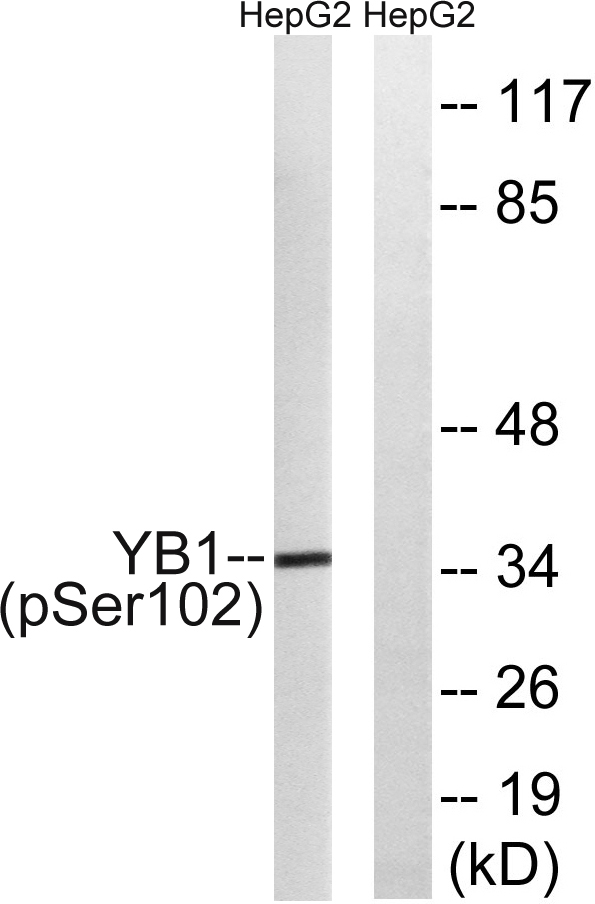
主要信息
Target
YB-1
Host Species
Rabbit
Reactivity
Human, Mouse, Rat
Applications
WB, ELISA
MW
36kD (Observed)
Conjugate/Modification
Phospho
货号: YP0489
规格
价格
货期
数量
200μL
¥4,680.00
现货
0
100μL
¥2,800.00
现货
0
50μL
¥1,500.00
现货
0
加入购物车


已收藏


收藏
详细信息
推荐稀释比
WB 1:500-1:2000; ELISA 1:40000; Not yet tested in other applications.
组成
Liquid in PBS containing 50% glycerol, 0.5% BSA and 0.02% sodium azide.
特异性
Phospho-YB-1 (S102) Polyclonal Antibody detects endogenous levels of YB-1 protein only when phosphorylated at S102.The name of modified sites may be influenced by many factors, such as species (the modified site was not originally found in human samples) and the change of protein sequence (the previous protein sequence is incomplete, and the protein sequence may be prolonged with the development of protein sequencing technology). When naming, we will use the "numbers" in historical reference to keep the sites consistent with the reports. The antibody binds to the following modification sequence (lowercase letters are modification sites):LRsVG
纯化工艺
The antibody was affinity-purified from rabbit antiserum by affinity-chromatography using epitope-specific immunogen.
储存
-15°C to -25°C/1 year(Do not lower than -25°C)
浓度
1 mg/ml
实测条带
36kD
修饰
Phospho
克隆性
Polyclonal
同种型
IgG
相关产品
抗原&靶点信息
免疫原:
The antiserum was produced against synthesized peptide derived from human YB1 around the phosphorylation site of Ser102. AA range:68-117
展开内容
特异性:
Phospho-YB-1 (S102) Polyclonal Antibody detects endogenous levels of YB-1 protein only when phosphorylated at S102.The name of modified sites may be influenced by many factors, such as species (the modified site was not originally found in human samples) and the change of protein sequence (the previous protein sequence is incomplete, and the protein sequence may be prolonged with the development of protein sequencing technology). When naming, we will use the "numbers" in historical reference to keep the sites consistent with the reports. The antibody binds to the following modification sequence (lowercase letters are modification sites):LRsVG
展开内容
基因名称:
YBX1
展开内容
蛋白名称:
Nuclease-sensitive element-binding protein 1
展开内容
别名:
YBX1 ;
NSEP1 ;
YB1 ;
Nuclease-sensitive element-binding protein 1 ;
CCAAT-binding transcription factor I subunit A ;
CBF-A ;
DNA-binding protein B ;
DBPB ;
Enhancer factor I subunit A ;
EFI-A ;
Y-box transcription factor ;
Y-box-binding protein 1 ;
YB-
NSEP1 ;
YB1 ;
Nuclease-sensitive element-binding protein 1 ;
CCAAT-binding transcription factor I subunit A ;
CBF-A ;
DNA-binding protein B ;
DBPB ;
Enhancer factor I subunit A ;
EFI-A ;
Y-box transcription factor ;
Y-box-binding protein 1 ;
YB-
展开内容
背景:
This gene encodes a highly conserved cold shock domain protein that has broad nucleic acid binding properties. The encoded protein functions as both a DNA and RNA binding protein and has been implicated in numerous cellular processes including regulation of transcription and translation, pre-mRNA splicing, DNA reparation and mRNA packaging. This protein is also a component of messenger ribonucleoprotein (mRNP) complexes and may have a role in microRNA processing. This protein can be secreted through non-classical pathways and functions as an extracellular mitogen. Aberrant expression of the gene is associated with cancer proliferation in numerous tissues. This gene may be a prognostic marker for poor outcome and drug resistance in certain cancers. Alternate splicing results in multiple transcript variants. Pseudogenes of this gene are found on multiple chromosomes. [provided by RefSeq, Sep 2015],
展开内容
功能:
Function:Binds to splice sites in pre-mRNA and regulates splice site selection. Binds and stabilizes cytoplasmic mRNA. Contributes to the regulation of translation by modulating the interaction between the mRNA and eukaryotic initiation factors (By similarity). Binds to promoters that contain a Y-box (5'-CTGATTGGCCAA-3'), such as HLA class II genes. Regulates the transcription of numerous genes. Promotes separation of DNA strands that contain mismatches or are modified by cisplatin. Has endonucleolytic activity and can introduce nicks or breaks into double-stranded DNA (in vitro). May play a role in DNA repair.,PTM:Cleaved by a 20S proteasomal protease in response to agents that damage DNA. Cleavage takes place in the absence of ubiquitination and ATP. The resulting N-terminal fragment accumulates in the nucleus.,PTM:In the absence of phosphorylation the protein is retained in the cytoplasm.,similarity:Contains 1 CSD (cold-shock) domain.,subcellular location:Shuttles between nucleus and cytoplasm. Predominantly cytoplasmic in proliferating cells. Cytotoxic stress and DNA damage enhance translocation to the nucleus.,subunit:Component of cytoplasmic messenger ribonucleoprotein particles (mRNPs). Interacts with AKT1, SFRS9, THOC4, MSH2, XRCC5, WRN and NCL. Can bind to DNA as a homomeric form, (EFI-A)n or as a heteromeric form in association with EFI-B. Homodimer in the presence of ATP.,
展开内容
细胞定位:
Cytoplasm . Nucleus . Cytoplasmic granule . Secreted . Secreted, extracellular exosome . Predominantly cytoplasmic in proliferating cells (PubMed:12604611). Cytotoxic stress and DNA damage enhance translocation to the nucleus (PubMed:14718551). Localized in cytoplasmic mRNP granules containing untranslated mRNAs (PubMed:25229427). Shuttles between nucleus and cytoplasm (PubMed:25229427). Localized with DDX1, MBNL1 and TIAL1 in stress granules upon stress (PubMed:18335541). Secreted by mesangial and monocytic cells after inflammatory challenges (PubMed:19483673). .
展开内容
组织表达:
Adrenal cortex,Bone marrow,Brain,Epithelium,Eye,Kidney,Lung,Muscle,Placenta,Skin,Te
展开内容
文献引用({{totalcount}})
货号: YP0489
规格
价格
货期
数量
200μL
¥4,680.00
现货
0
100μL
¥2,800.00
现货
0
50μL
¥1,500.00
现货
0
加入购物车


已收藏


收藏
Recently Viewed Products
Clear allToggle night Mode
{{pinfoXq.title || ''}}
Catalog: {{pinfoXq.catalog || ''}}
Filter:
All
{{item.name}}
{{pinfo.title}}
-{{pinfo.catalog}}
主要信息
Target
{{pinfo.target}}
Reactivity
{{pinfo.react}}
Applications
{{pinfo.applicat}}
Conjugate/Modification
{{pinfo.coupling}}/{{pinfo.modific}}
MW (kDa)
{{pinfo.mwcalc}}
Host Species
{{pinfo.hostspec}}
Isotype
{{pinfo.isotype}}
产品 {{index}}/{{pcount}}
上一个产品
下一个产品
{{pvTitle}}
滚轮缩放图片
{{pvDescr}}

























